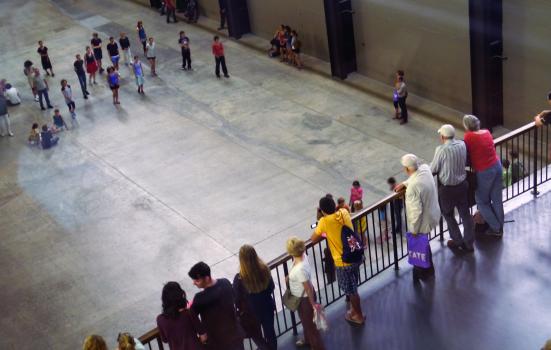How do the public make value judgements about works of art? To find out, Saul Albert did some eavesdropping at Tate Modern.

'Des gens qui regardent des gens' Groume, 2012 (CC-BY)
The difficulty of coming up with standards for evaluating artworks that balance subjective and objective measures of aesthetic value has worried some of the world’s greatest philosophers since the Enlightenment. It’s hardly surprising, then, that this problem still haunts curators, artists, and arts professionals struggling to justify decisions about cultural funding.
The interactional relevance of an artwork provides far more evidence about how people evaluate art than simple statements of ‘like’ or ‘dislike’
Although both quantitative and qualitative methods for measuring aesthetic value may have developed a great deal ̶ from narrative interviews and systematic surveys to neuroaesthetic studies using fMRI scanners ̶ my research shows that it’s useful to revisit some long-standing philosophical issues to work out how to use these evaluation methods in practical and aesthetically sensitive ways.
Current practice
Methods for evaluating people’s responses to visual art are usually informed by the professional standards, materials and best practices of the researchers who do the evaluation. Social scientists tend to draw distinctions between ‘qualitative’ or ‘quantitative’ methods, then argue over their efficacy on that basis.
However, the practical application of such methods varies widely, even between studies on the same side of the ‘qual/quant’ methodological divide. For example, common quantitative measures range from straight-forward recordings of gallery visitors’ ‘dwell time’ in front of exhibits, to ‘Likert scale’ surveys of the degree to which subjects ‘strongly agree’ or ‘strongly disagree’ with a series of stereotypical statements about their experiences and opinions.
Larger-scale studies tend to look at visitor numbers in relation to ticket prices, sales of artworks or column inches and airtime generated in the media. At the extreme quantitative end of the spectrum, experimental studies of people’s responses to artworks in neuroaesthetics test hypothetical models of aesthetic judgment, often using artworks as stimuli for neuroimaging scans, then applying advanced statistical analysis to find interpretable results.
Preferred approach
These methods are somewhat controversial in the arts, as recent debate over Arts Council England’s plans to introduce a system of Quality Metrics has highlighted. Traditionally artists, curators and gallerists have relied more on informal peer review in the form of expert opinion and critical reviews in the arts press. This may explain why evaluation in the arts has tended to opt for qualitative methods that more closely resemble these processes, such as narrative interviews, open-ended question surveys, focus groups and facilitated discussions with expert consultants.
Sometimes these evaluation methods ̶ often run by artists or arts educators ̶ are carefully designed and engaging, and almost function as new interpretative participatory artworks in themselves. However, a glimpse at a visitors book suggests that whatever is being measured ̶ either qualitatively or quantitatively ̶ often says far more about how the measurement has taken place than how a specific artwork is evaluated in relation to other artworks.
Philosophical issues
To see how evaluative strategies relate to people’s actual experiences of art requires a short philosophical detour beneath these entrenched methodological distinctions.
Most researchers in sociology or psychology draw on either ‘internalist’ or ‘externalist’ philosophical explanations of aesthetic experience. Internalist explanations are based on an understanding of aesthetic response as an inherently psychological, cognitive process which is essentially subjective, private and therefore incorrigible: that there’s no accounting for taste.
According to this view, since we experience artworks internally, we should use methods that can reflect internal processes in ways that we can then measure either qualitatively or quantitatively.
By contrast the ‘externalist’ view sees our experiences of art as shaped by social norms of education, class and acculturated taste. According to this view, if our responses to art reflect cultural conventions rather than some internal aesthetic sense, we should focus on the social factors that must shape our subjective experiences.
The problem is that each of these explanations result in a situation where ̶ since we can’t measure people’s experiences of art directly ̶ we end up measuring things that we intuitively believe must either internally reflect or externally shape our ineffable aesthetic experiences. In following our intuitions about the relevant things to measure, we choose evaluation methods that reinforce rather than challenge our intuitions.
But if we want to understand how people evaluate artworks, the most important thing to figure out is what they themselves treat as relevant to their lived experience in any given situation. Only then can we select the best methods for the job.
Studying gallery visitors
A simple way to approach this task is to go and look at what visitors actually do when they visit art galleries together.
As people usually go to galleries together, they tend to move as a group: one person leans, then starts to move, initiating a group shuffle to the next exhibit. However, when someone starts to lean but other members of the group stay put, the ‘leader’ then usually straightens up and looks at the artwork a while longer, creating a shared, aesthetic experience strongly influenced by their social interactions [1]. When people interact and move around an exhibition together in a coordinated way, talking about an artwork, pointing out specific features, or making little ‘response cries’ of surprise or delight, overhearing researchers can find out a great deal about the lived sequential structure and organisation of their aesthetic experiences.
In conventionally hung exhibitions of Constable paintings, for example, interactional studies have shown that people tend to move silently from one painting to another, pausing only to read the information labels: “a silent shuffling around the gallery walls” [2]. Examining how people determine aesthetic value in this setting may reveal more about conventional exhibition-visiting ̶ what sociologist Dirk vom Lehn calls the ‘museum ritual’ ̶ than about how they evaluate the art itself.
Beyond the ritual
To explore people’s interactions around art beyond the museum ritual I spent four months doing research at Tate Modern in 2012, working on artist Tino Sehgal’s Unilever commission for the Turbine hall entitled ‘These Associations’. Sehgal's Turner Prize nominated artwork employed a diverse group of people to mingle with visitors on the ground floor of the hall, occasionally assembling into coordinated patterns of movement, or breaking off to talk with individual visitors.
By working as one of these so-called ‘associates’, I gained permission from Sehgal to record the action from the mezzanine balcony above. This vantage point also allowed my camera’s microphone to pick up conversations between visitors who, having walked into the Tate from the banks of the Thames, tended to congregate on the balcony as they encountered These Associations, often unexpectedly.
The most striking finding was that people approached their aesthetic evaluations in very different ways, each of which could be amenable to a different combination of research methods. Some people evaluated These Associations by mocking or defending it, by arguing over its status as an artwork, and others by expressing curiosity about its organisation and rationale. Through this process, they also positioned themselves in relation to each other and the artwork, showing themselves as knowledgeable, or mocking and dismissive, or impressed by this kind of art.
Each conversation reflected quite different structures of activity from the kind of thing people might do in an exhibition of Constable paintings where ‘dwell time’ might actually be an effective measure. One of the things they often did in practice was to work together to figure out what this thing was, and how ̶ and whether ̶ it should be evaluated as art. On the rare occasions when people did say something like “It’s beautiful” or “I like it”, these expressions were always embedded within an ongoing social interaction that was far more revealing about their joint aesthetic experiences than these kinds of stock phrases alone.
Visitors’ conversations revealed what These Associations meant to these particular visitors in practice, in this specific situation. The interactional relevance of an artwork therefore provides far more evidence about how people evaluate art than simple statements of ‘like’ or ‘dislike’.
A shared experience
The Tate research showed that in practical terms, there is no evidence from people’s interactions that they experience artworks differently from how they experience, laugh at or describe any other everyday phenomena. It shows how people work together to negotiate the relevant parameters, methods and categories before making aesthetic judgements. They figure out how to do this for themselves.
This challenges theories of art that try to measure some internal ineffable aesthetic attitudes, or enumerate some set of external factors that shape our similarly ineffable aesthetic conditioning. Subjective experience and cultural conditioning are clearly important to how people evaluate art, but my research shows that we can guide our intuitions and choice of research methods by examining evidence of how they collaborate in situ to evaluate artworks themselves through social interaction.
This insight helps us understand what to measure and quantify when conducting research into people’s aesthetic judgements, because it shows that internalist and externalist philosophical distinctions are a moot point in empirical terms. Both qualitative and quantitative methods are potentially useful, but our choice of research methods should be guided by how people actually behave around a specific exhibit and the ways they work out how to evaluate it together in practice.
Implications for research
For arts professionals, curators and artists, my research shows that evaluative measures (qualitative or quantitative) are most useful when selected and combined in ways that take into account how people encounter an exhibit in practice, and how they observe each other’s actions and share aesthetic experiences in the course of social interaction.
Methodological choices can be made in ways that reflect people’s lived experiences of specific artworks in any given situation. Quantifying dwell-time may work for measuring people’s aesthetic experiences during an exhibition of Constable paintings, but a different combination of methods can be used to measure people’s responses to less conventionally displayed artworks such as Sehgal’s These Associations far more effectively. Analysing visitor interactions is a vital additional step that artists, curators and all arts professionals should consider before designing their evaluation procedures.
Wider applications
This approach is not only useful for evaluating people’s aesthetic experiences. Understanding visitor response to encountering a specific artwork can also guide education programmes to produce experiences for groups of visitors with access needs. Similarly, with site-specific artwork, visitors’ actions and experiences in the original setting can be documented and recreated systematically, allowing such artworks to be conserved and emulated elsewhere as an experiential whole.
Seeing evaluation in the arts as an exploration of aesthetic experience in this way transforms it from a funding-related drudgery into a highly creative practice that all arts professionals can approach with due care and curiosity.
Saul Albert is a researcher in the Cognitive Science Group in the School of Electronic Engineering and Computer Science at Queen Mary University of London.
saulalbert.net
Tw: @saul
E: s.albert@qmul.ac.uk
1 See vom Lehn, Dirk. 2013. Withdrawing from exhibits: The interactional organisation of museum visits. In Haddington, Pentti (Ed.), Lorenza Mondada (Ed.) and Maurice Nevile (Ed.). Interaction and Mobility. Language and the Body in Motion., 65-90. Berlin, Boston: De Gruyter
2 See vom Lehn, Dirk. 2013. ‘Museum Drama’ and ‘Interaction Order Sui Generis’: works of art as hubs for co-orientation. In Edgley, C. (Ed.), 2013. The Drama of Social Life., 211-28. Farnham: Ashgate





Comments
szczels replied on Permalink
Constable